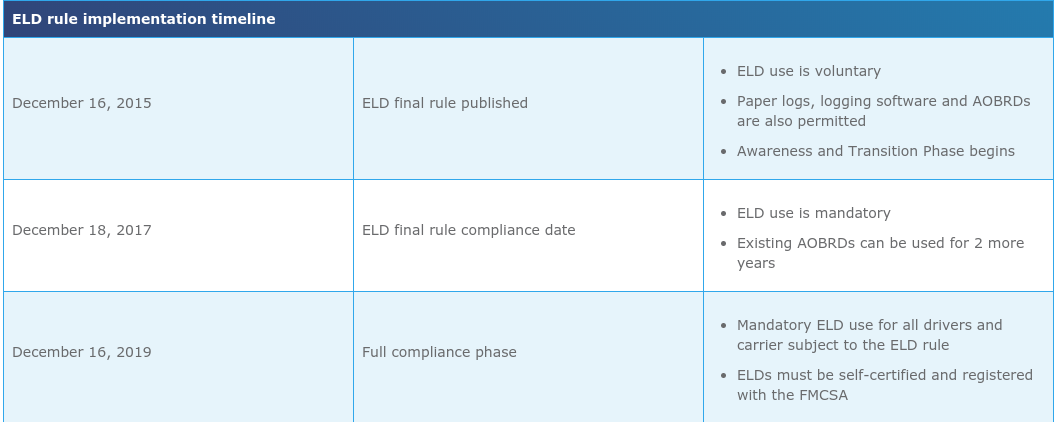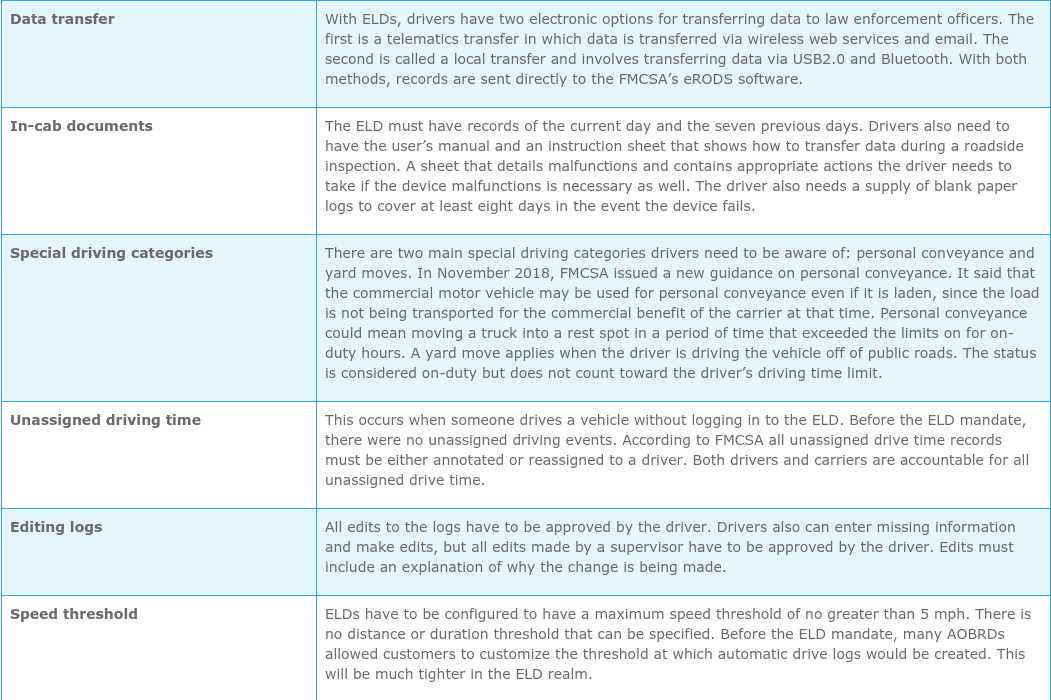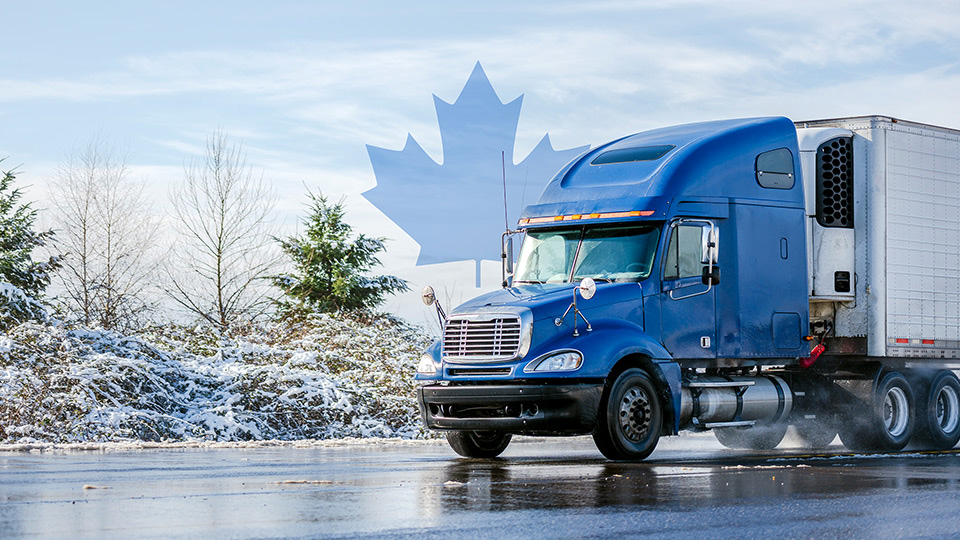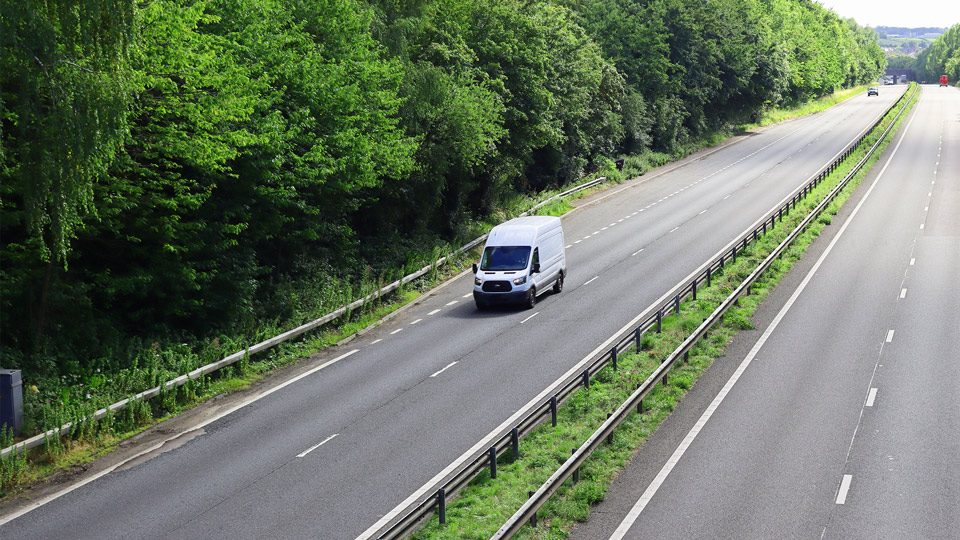
AOBRD to ELD: fast track guide for fleets

Table of contents
Get ready for the ELD full compliance deadline
When the United States Congress mandated the use of electronic logging devices (ELD), trucks with existing automatic on-board recording devices (AOBRDs) were grandfathered in for two years. That two-year extension will be expiring on December 16, 2019, at which time all commercial vehicle drivers who are required to prepare Hours of Service records of duty status (RODS) will have to do so using an ELD.
About this guide
This guide is intended to help fleets make a smooth transition from AOBRDs to ELDs, by providing an overview of the technology and the changeover process. It will explain what needs to be done to get started down the path to full compliance.
What you’ll learn:
- Differences between AOBRDs and ELDs
- ELD Technical Overview
- Transition Plan
- Proper Training

Why transition now?
Although the deadline requiring the switch from AOBRDs to ELDs isn’t until December 2019, fleets should consider starting to switch now. Here are some reasons why:
- Take time for driver training — ELDs work differently than AOBRDs and additional driver training will be required, especially in the areas of unassigned logs, yard moves and data transfer, just to name a few.
- Get ahead of the pack — Migrating to ELDs sooner rather than later could give a fleet a competitive advantage over those that choose to switch at the last minute. By the time the deadline hits, ELD fleets will have already worked out any issues their drivers may have experienced and will have determined how to offset any losses to productivity that may have resulted from the switch.
- Easier roadside inspections — The FMCSA’s eRODS software is designed to receive ELD data from any ELD vendor in a standardized format, to simplify the roadside inspection process. Having AOBRDs slows down inspections, and your drivers end up spending more time on the roadside, due to the lack of a standardized inspection process.
According to the Journal of Commerce, eight months into the use of ELDs, the biggest effect of the mandate wasn’t a loss of drivers, but of driving hours.
The reality is that like it or not, ELDs will soon replace AOBRDs. Although there are some exemptions, electronic logging is now an industry standard and for many fleets, will become an integral part of their day-to-day operations.
The good news
ELDs offer many benefits, the biggest being access to real-time data. Other key benefits include the ability to monitor fuel usage and manage driver safety, improve Hours of Service performance, and track arrival and departure times.
Like any technology solution there will be a learning curve with ELDs. Fleets need to take action today to get a transition process in place and devise a training program for drivers and office staff to ensure the smoothest transition possible.
AOBRD vs. ELD
An AOBRD, or automatic on-board recording device, is an electronic device that records a driver’s Hours of Service (HOS) as laid out in the U.S. Hours of Service of Drivers Regulations Section § 395.15 by the Federal Motor Carrier Safety Administration (FMCSA). As mentioned earlier, AOBRDs were grandfathered in as being compliant when the ELD mandate went into effect on December 18, 2017.
According to FMCSA, an ELD is:
“technology that automatically records a driver’s driving time. This allows easier, more accurate Hours of Service recordkeeping. An ELD monitors a vehicle’s engine to capture data on whether the engine is running, whether the vehicle is moving, miles driven, and duration of engine operation (engine hours). ELD manufacturers must certify that their products meet the technical standards in the ELD rule.”
Key differences between AOBRD and ELDs
While both AOBRDs and ELDs are designed to record a driver’s duty status, ELDs have a number of important advancements:
- Internal synchronization is more clearly defined in ELDs.
- Records location information about the truck at each duty cycle change, plus every 60 minutes while the vehicle is in motion.
- Provides a graph grid of the driver’s duty status changes.
- Warns driver of unassigned driver time/miles upon login.
- Defaults to on-duty not driving status when the vehicle has stopped for five consecutive minutes and there is no driver response to prompt the ELD.
- Synchronizes to Universal Coordinated Time.
- Enhanced resistance to tampering.
AOBRD vs. ELD — more differences

Electronic logging devices — technical overview
ELDs have to capture more data than AOBRDs. This includes: date and time, location (accurate to within one mile in normal operation), engine hours, vehicle miles, driver information, vehicle information, and carrier.
On its website, FMCSA lists the features all ELDs are required to have[1]. Some key things to note include that the device must show the driver as driving when the vehicle reaches 5 mph and the device must automatically default to on duty when the vehicle is stopped, unless the driver takes action. The device also has to automatically generate vehicle location. Anyone using the ELD must have an account, and only one driver is allowed on each account.
FMCSA also requires ELD manufacturers to self-certify that their devices meet the ELD specifications contained in the rule.
The Geotab Cloud ELD platform interconnects the Geotab GO telematics device with a mobile device running the Geotab Drive app (available for Android and iOS) through a secured cloud-based server operating the MyGeotab fleet management software. Unlike hard-wired or Bluetooth paired solutions that use a time-based approach with periodic status checks, the GO device continuously records and transmits data to the cloud-based program to effectively monitor and record HOS, including RODS and Driver Vehicle
Inspection Reports (DVIRs).
Geotab has registered its Geotab Cloud ELD with FMCSA indicating that it meets the necessary specifications.

Transition plan for ELDs
When it comes to transitioning to ELDs, it does not have to be all or nothing. If a fleet begins now, it can complete a slow rollout by the December 2019 deadline.
Conduct a pilot program
Start by reviewing the offerings from various ELD makers. Once the fleet has determined which ELD it is going to use, fleet management needs to ask for a pilot program.
Top drivers or those who are technology-savvy and enthusiastic are a good choice as the first users of the ELDs. Get them properly trained and allow them one to two weeks to practice using the ELDs. Once they are trained and successfully using the ELD, they will become champions for it and can help the fleet roll it out to the rest of the drivers.
What a successful transition looks like
Here is a quick overview of the steps to successful deployment:
1. Pre-deployment is the time to reinforce the benefits of ELDs with drivers and to make sure vehicles are ready to have ELDs installed. It’s also a good time to review and update HOS policies and stress that the fleet’s goal is 100% compliance with HOS rules.
2. During the initial pilot deployment, set drivers up with accounts, make sure they know how to log in to the devices, and ensure all necessary documentation is in the cab of the vehicle.
3. Driver training needs to hit on all the areas that differ from what drivers using AOBRDs are familiar with. Emphasize points like thresholds for duty status changes, personal conveyance and yard moves, proper data transfer methods and edits.
4. Training of back office staff is also important for helping them understand that they can only suggest changes to logs and to ensure they know how to transfer logs in the event of an audit.
Training tips
To be successful in switching to ELDs, training is critical. The top areas to focus on during training are:
- Making sure drivers understand the thresholds for automatic duty status
- Teaching them how to successfully transfer data from the ELD to the law enforcement official via either the telematics or local transfer method
- Explaining the various ways the ELD can malfunction. FMCSA has information on both the types of malfunctions and what drivers need to do in the event of a malfunction[2]. Educate your back office staff about their responsibilities when malfunctions are reported by drivers.
- Ensuring drivers understand how to edit logs and are aware that they must approve all edits made by supervisors.
Take a step-by-step approach when transitioning from AOBRDs to ELDs. Make sure the plan covers what needs to be done prior to deploying the ELDs, driver training and training for back office staff.
Giving drivers and ELD administrators ample time to learn and ask questions will result in the smoothest transition. Once the fleet has begun the transition from AOBRDs to ELDs, schedule ongoing training sessions with drivers and offer coaching where needed.
Putting it all together
Although making the switch from AOBRDs to ELDs may seem daunting, it doesn’t have to be. With some basic planning and training, ELDs can become a valuable part of your fleet management program for compliance and beyond.
The FMCSA web site (www.fmcsa.dot.gov/hours-service/elds/electronic-logging-devices) is a good source of information about ELDs. It provides definitions and technical information about ELDs, has an FAQ section, as well as a section for drivers and carriers in addition to a list of resources.
For more information and training tips on ELDs, please visit: www.geotab.com/eld
References
Post Tags
About Geotab
Geotab is a global leader in connected transportation solutions. We provide telematics — vehicle and asset tracking — solutions to over 50,000 customers in 160 countries. For more than 20 years, we have invested in ground-breaking data research and innovation to enable partners and customers, including Fortune 500 and public sector organizations, to transform their fleets and operations. With over 4 million subscriptions and processing more than 75 billion data points a day, we help customers make better decisions, increase productivity, have safer fleets, and achieve their sustainability goals. Geotab’s open platform and Marketplace, offers hundreds of third-party solution options. Backed by a team of industry leading data scientists and AI experts, Geotab is unlocking the power of data to understand real-time and predictive analytics — solving for today’s challenges and tomorrow’s world. To learn more, visit www.geotab.com, follow @GEOTAB on X and LinkedIn or visit the Geotab Blog.
© 2024 Geotab Inc.All Rights Reserved.
This white paper is intended to provide information and encourage discussion on topics of interest to the telematics community. Geotab is not providing technical, professional or legal advice through this white paper. While every effort has been made to ensure that the information in this white paper is timely and accurate, errors and omissions may occur, and the information presented here may become out-of-date with the passage of time.
Recent News

When is the right time to switch out your ELD?
June 29, 2022

Your comprehensive guide to the Canadian ELD mandate
May 16, 2022

Combating rising fuel prices with fuel performance incentives
April 28, 2022
.jpg)
Customizing mobile workflow and fleet management to better serve drivers
June 5, 2020





